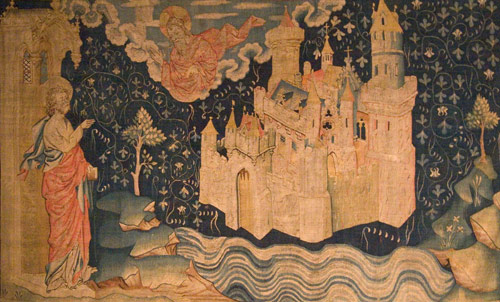Fr : version française / En: english version
Heavenly Jerusalem
The legacy of a continuous occupation dating back to the Stone Age and Medieval upheaval, European city streets were often narrow, dark and winding. As elsewhere in the world, people nurtured the dream of a city protected by ramparts.
And there came unto me one of the seven angels which had the seven vials full of the seven last plagues, and talked with me, saying, Come hither, I will shew thee the bride, the Lamb's wife.
And he carried me away in the spirit to a great and high mountain, and shewed me that great city, the holy Jerusalem, descending out of heaven from God,
Having the glory of God: and her light was like unto a stone most precious, even like a jasper stone, clear as crystal;
And had a wall great and high, and had twelve gates, and at the gates twelve angels, and names written thereon, which are the names of the twelve tribes of the children of Israel...
And he that talked with me had a golden reed to measure the city, and the gates thereof, and the wall thereof.
And the city lieth foursquare, and the length is as large as the breadth: and he measured the city with the reed, twelve thousand furlongs. The length and the breadth and the height of it are equal.
And he measured the wall thereof, an hundred and forty and four cubits, according to the measure of a man, that is, of the angel.
And the building of the wall of it was of jasper: the city was pure gold, like unto clear glass...
And the twelve gates were twelve pearls; every several gate was of one pearl: and the street of the city was pure gold, as it were transparent glass.
And I saw no temple therein: for the Lord God Almighty and the Lamb are the temple of it.
And the city had no need of the sun, neither of the moon, to shine in it: for the glory of God did lighten it, and the Lamb is the light thereof.
Extract from the Apocalypse of John (King James Version)
Many believed the New Jerusalem—so eagerly anticipated by Christians and seen as a post-Apocalyptic utopia—was the representation of paradise.


















